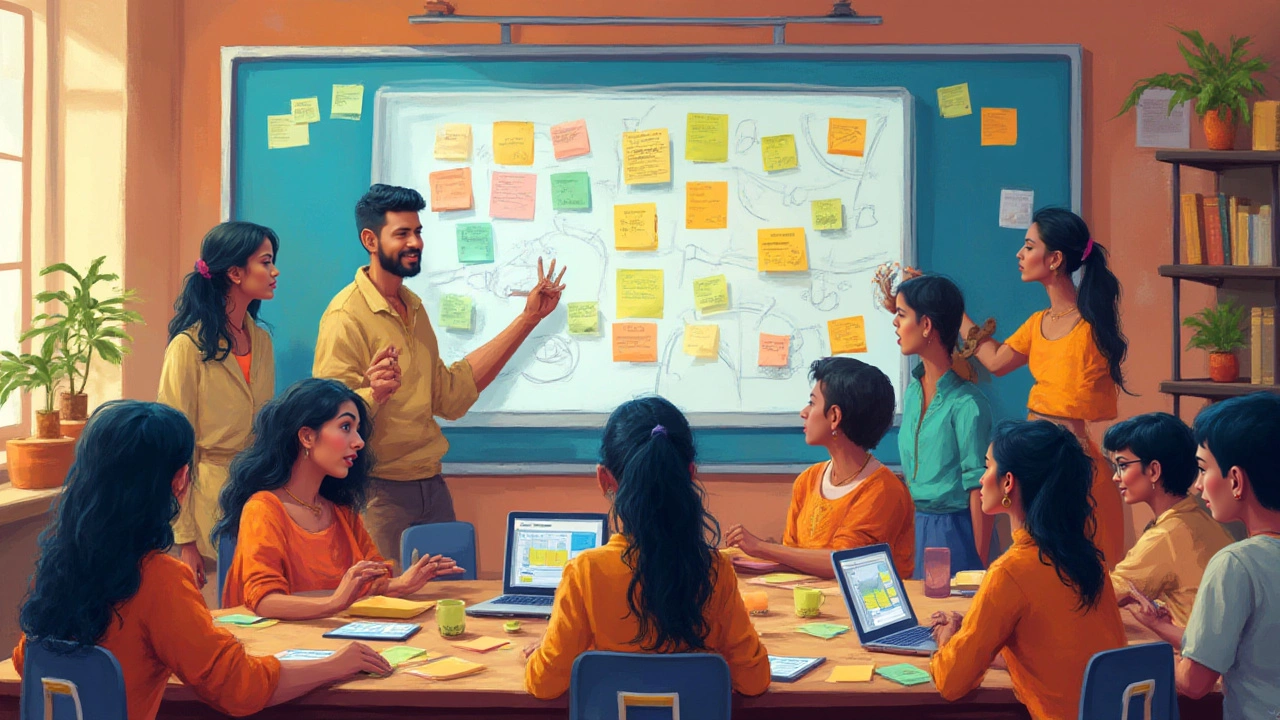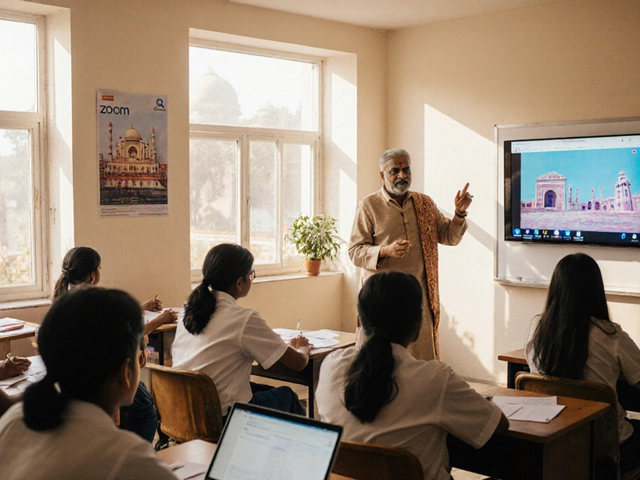Jul
4

- by Dhruv Ainsley
- 0 Comments
Most people dive into online learning hoping to pick up a new skill or teach a concept without stumbling. But somewhere between clicking 'enroll' and the end-of-semester feedback, things can get messy. Courses flop. Students zone out. Instructors wonder if anyone’s actually listening. Why does this happen? Turns out, the secret sauce comes down to three strange but powerful words. They’re called the three P’s of eLearning, and if you ignore them, you’re basically rolling dice with your lesson.
Why the Three P’s Matter More Than Fancy Tech
Sure, everyone’s talking about the next big eLearning platform. Some platforms use AI to suggest lessons. Others track your progress with cool dashboards. But no amount of technical glitter can save a course if it lacks the good stuff. Good online learning needs a backbone. Change the platform, update the app, redesign the home page all you want—without the three P’s, education goes nowhere fast.
The first P, Planning, is about laying out your course before you build anything. You wouldn’t bake a cake without reading the recipe, right? Planning helps you know exactly where you’re going. Research by the eLearning Guild in 2023 showed that projects with planning phases twice as long as the build phases had 37% better learner satisfaction. That’s not a typo. Want better reviews and results? Spend more time upfront deciding what you’re making.
Preparation comes next. It’s the nuts and bolts—content, quizzes, activities, and the tech checks needed to keep things running. Students drop out when a class feels sloppy, when directions are unclear or videos don’t load. A 2024 Harvard Extension study found that online courses with clear instructions saw 46% fewer support requests from students. Preparation is the unsung hero that saves hours of fixing things later.
Participation is the final P, and it gets overlooked the most. Watching videos in silence just isn’t enough. If learners aren't actively discussing, posting, or doing real work, engagement plummets. And here’s the kicker: According to Coursera’s 2022 engagement report, courses with at least one required group activity per week had 60% higher completion rates. Participation is what turns a bland, forgettable Zoom call into something memorable.
Breaking Down Planning: The Map for Your eLearning Adventure
Ever start a road trip without a GPS or a playlist? Online learning without planning feels just as random. Planning is about designing a learning journey, not winging it until the night before launch. You want students to actually reach the destination, not get lost halfway through.
First, create your course outcomes. What should the learner walk away with? Be specific. Instead of “understand World War 2,” try “identify key political causes of World War 2 and analyze their impact.” Clarity here prevents confusion down the line. Learning expert Dr. Carla Lane found that courses listing clear objectives on the front page saw course evaluations jump by nearly 30% in her 2021 study.
Next, storyboarding becomes your best friend. Lay out the order of topics, activities, and assessments before writing a single word of content. Many universities now require instructors to submit a storyboard before giving them the green light. It makes changes painless and lets you spot boring gaps early.
Gathering resources comes after the storyboard. Don't just rely on standard reading lists—think about podcasts, infographics, and interactive tools. In a 2023 LinkedIn Learning survey, courses featuring multimedia links got 42% more replays than text-only formats.
Don’t skip deadlines. Map out when things get released, when major assignments are due, and where checkpoints fall along the way. Building this schedule before you start developing prevents a last-minute crunch. Use a simple table like this to keep things clear:
| Week | Topic | Assignment | Due Date |
|---|---|---|---|
| 1 | Introduction | Discussion Post | July 8 |
| 2 | Core Concepts | Quiz 1 | July 15 |
| 3 | Application | Project Outline | July 22 |
Planning isn’t glamorous. You don’t get compliments for a well-organized Google Drive. But it’s what keeps online learning on the rails. If an assignment feels out of place or a topic falls flat, chances are, someone didn’t plan far enough ahead.
Preparation: Making Sure the Engine Actually Runs
You’ve got the map. Now you need a working engine. Preparation is where you stop talking about learning and actually put all the pieces together. A common mistake? Trying to improvise videos or slides at the last minute. Instead, this is your chance to test, edit, and polish before anyone else sees a thing.
First, gather all your content. Write the scripts, record the screens, make the handouts. Don’t just settle for a single format. Relying on 50-minute lecture videos is the fastest way to lose attention. Research from EdX in 2023 proved that videos under six minutes held student attention 72% better than longer formats. Divide key lessons into bite-sized modules. Offer audio files and written transcripts for flexibility, especially for those with slow internet or accessibility needs.
Next, build your interactive elements. These can be quizzes, polls, forums, or even quick check-in chats. The University of Central Florida published a case study in 2024 showing that courses with three or more quiz points per week had a 30% lower dropout rate. Real-time feedback keeps everyone on track.
Test everything—twice. Broken links make learners furious. Tech issues account for over 25% of student complaints, according to Online Learning Consortium reports. Run your course in a “sandbox” first; recruit a friend or colleague to walk through every click and page. Fix any confusing language or missing materials before launch day.
It’s easy to forget the small stuff. Are your instructions crystal clear? Have you included tech “how to” guides for new learners? A FAQ can prevent 100 panicked emails on opening day.
Lastly, make your content mobile-friendly. Over 65% of learners checked course material on a phone at least once a week, as found by Digiday Education’s 2022 survey. Avoid tiny fonts and overloaded graphics. Test everything on different devices to make sure your course doesn’t turn into a pixelated mess.
- Break content into smaller pieces for easier mobile viewing.
- Add resource download links for spotty connections.
- Set up quick feedback channels to handle tech or content issues fast.
Preparation isn’t a one-time thing. Course updates, correction of typos, and new resources keep things fresh and responsive. Review your own lessons once a semester—sometimes, the instructions you wrote last year won’t make sense to anyone anymore. Save yourself and your students the headache by keeping everything sharp.

Participation: Turning Passive Viewing into Active Learning
Imagine sitting through a three-hour online class, microphone off, video off, and nobody’s talking. Now multiply that by a whole semester. Doesn’t sound like learning, does it? Participation is what brings eLearning to life. Courses aren’t just digital libraries—they’re meant to be interactive, even if people are miles apart.
Active participation makes a world of difference. In a FutureLearn engagement analysis from 2023, courses requiring at least two learner posts per week had a meaningful jump—over 50%—in end-of-course project quality compared to low-participation classes. That’s not about busywork. It’s proof that talking, sharing, and bouncing ideas around strikes a nerve for real understanding.
Start with simple discussion boards. Ask for opinions, not just regurgitated facts. Open with a question like “What’s the biggest obstacle to working from home?” instead of “Summarize chapter 2.” When learners connect topics to their own experience, everyone remembers more.
Build group projects that force teamwork, not just split-up assignments. In a Stanford 2024 study, synchronous breakout groups delivered 35% higher project scores than asynchronous solo work, even though students grumbled at first. Turns out, a little pressure to talk it out helps everyone learn faster and deeper.
Gamify the process. Add leaderboards for quizzes, badges for course milestones, or bonus points for responding to classmate posts. According to a 2023 Class Central report, gamified courses saw 22% more repeat logins each week. Just don’t overdo it—nobody wants to feel like they’re just racking up useless points.
Host live Q&As or office hours. Even just a 20-minute pop-in video chat makes the course feel alive, and it gives shy students a chance to ask what’s been on their minds. When people see real faces and hear honest feedback, they’re way more likely to come back week after week.
If you’re teaching, give rapid feedback. Don’t let questions sit for days. Use voice memos or short video replies to make things personal. Students remember kind, fast responses. And if you’re a learner? Speak up early. Asking questions or joining a side discussion isn’t just for show—it builds your network and multiplies your takeaways.
Pitfalls: What Happens When You Skip a P
Miss any of the three P’s, and your online course can fall apart fast. Skip planning, and you’re lost before you upload that first video. Students notice when lessons wander or assignments come out of nowhere. They start checking out—or worse, dropping the class outright. A survey by Canvas in 2022 found disorganized courses had nearly double the dropout rate of those with posted outlines and clear roadmaps.
Forget preparation, and brace yourself for chaos. Bugs, broken tutorials, and confusing instructions are the top three reasons students reach out to support, EdSurge reported in 2023. If you’ve ever gotten a message about an assignment link not working two hours before a deadline, you know the pain.
Leave out participation, and even the best-designed course will flop. Watching videos is not the same as learning. If there’s no prompt to interact, learners forget what they saw halfway through. Udemy research from 2024 showed passive-only courses had a shockingly low 7% completion rate, compared to 40% in courses nudging students to comment or share.
Bottom line? You can have the coolest tech, the best experts, and snazzy graphics. None of it matters if you forget Planning, Preparation, or Participation. Want a course people actually finish? Pay attention to the three P’s. It’s not magic—it’s just how brains (and online classes) work best.
Tips for Mastering the Three P’s in Your Next eLearning Course
No two courses are ever the same, but there are a few hacks that make wrangling the three P’s a whole lot easier. Here’s what the pros use, plus some pro moves for getting an edge.
- eLearning works best when you plan backwards. Start with the final assignment and work out what skills are needed at each step.
- Use “just-in-time” instructions—release only what’s needed for the week ahead to prevent overwhelm.
- Automate routine feedback with tools like instant quizzes or chatbot office hours, but always leave room for genuine interaction.
- Mix up formats: swap a reading list for a podcast, or offer a live demo instead of a standard slide deck. Variety keeps brains awake.
- Share your roadmap and calendar openly. The more transparent you are, the fewer confused emails you’ll get.
- If you’re a learner: build a study group—even a text chat with two classmates raises your odds of finishing by a huge margin, according to a Skillshare user survey in late 2023.
- Don’t aim for perfect. Courses are living things. Gather feedback constantly and update. A short survey at the midway point leads to sharper changes than waiting until the end.
Schools, businesses, and side-hustlers worldwide are still figuring out what makes online courses “click.” But the evidence is clear. The three P’s of eLearning—Planning, Preparation, and Participation—aren’t just buzzwords. They’re the building blocks that take course ideas off the back burner and turn them into something people actually enjoy, remember, and complete. That’s how you win, whether you’re teaching or learning from your couch.





